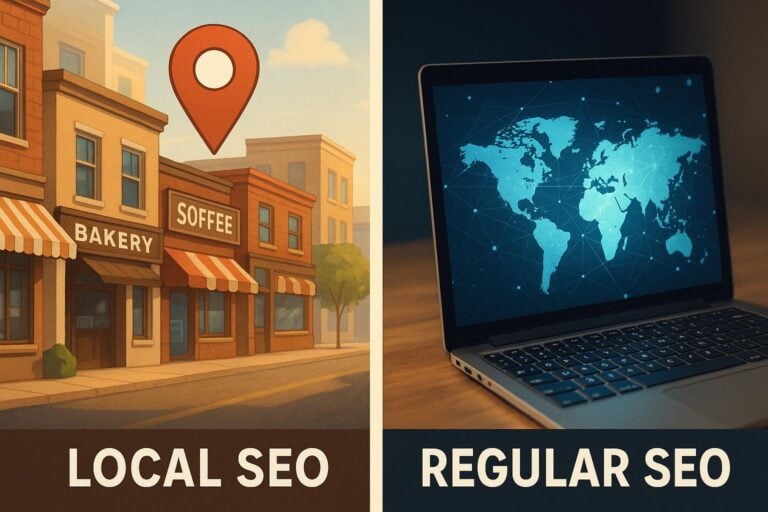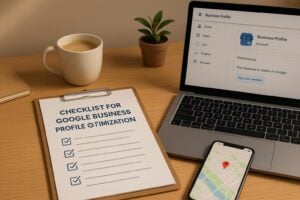Local SEO focuses on connecting businesses with nearby customers, while Regular SEO targets a broader, often global, audience. Choosing the right strategy depends on your business type and goals.
Key takeaways:
- Local SEO: Ideal for businesses relying on physical visits or serving specific areas (e.g., restaurants, plumbers). It emphasizes proximity, accurate business info, and Google Business Profile optimization.
- Regular SEO: Best for businesses with a wider reach (e.g., e-commerce, software). It prioritizes content quality, backlinks, and ranking for general, non-location-specific keywords.
- Hybrid Approach: Combining both can maximize visibility, especially for businesses with local and national audiences.
Quick Comparison:
| Criteria | Local SEO | Regular SEO |
|---|---|---|
| Target Audience | Local customers near your business | National or global audience |
| Keywords | Location-specific (e.g., "plumber NYC") | Broad, non-geographic (e.g., "best software tools") |
| Focus | Google Business Profile, local reviews | Content, backlinks, site performance |
| Best For | Service-based, retail, and local businesses | E-commerce, SaaS, online services |
Use Local SEO for local traffic and Regular SEO for wider reach. For many businesses, combining both is the most effective strategy.
What Is Regular SEO?
Regular SEO, often called organic or traditional SEO, is all about improving your website’s visibility in global search results. Unlike local SEO, which focuses on specific geographic areas, regular SEO aims to connect with audiences worldwide – anyone searching for your products, services, or information.
Think of it this way: when someone types "project management software" or "how to start a podcast" into a search engine, they’re not necessarily looking for something in their neighborhood. Regular SEO ensures your website shows up for these broader, location-independent searches. Let’s take a closer look at the goals and strategies that define this approach.
Regular SEO Goals and Focus
The primary goal of regular SEO is to rank higher for important keywords, regardless of where the searcher is located. It’s all about building your website’s authority and relevance on specific topics.
Regular SEO targets informational, navigational, and transactional searches that don’t include location-specific terms. For example, someone searching for "best email marketing strategies" or "WordPress hosting comparison" is seeking general information or solutions – not something tied to a specific city or region.
Key focus areas include:
- Technical performance: Ensuring your website loads quickly and works flawlessly on all devices.
- Content quality: Providing detailed, reliable, and engaging resources that address user needs.
- Authority building: Establishing your site as a trusted source in your industry through backlinks and expertise.
Regular SEO Methods
To succeed with regular SEO, a combination of strategies is used to boost rankings and overall visibility. Here are the core methods:
- Keyword research and optimization: This involves identifying the terms your audience uses when searching for your offerings and optimizing your website’s pages, blog posts, and other content around those keywords. The focus here is on search volume and competition, not geographic relevance.
- Content creation and marketing: Regularly publishing high-value content is critical. This includes blog posts, guides, videos, and other formats that meet user needs. At the same time, optimizing your site’s speed, mobile responsiveness, and URL structure ensures search engines can crawl and index your content effectively.
- Link building: Earning backlinks from credible websites in your industry signals to search engines that your content is trustworthy and valuable. This might involve guest blogging, creating shareable resources, or collaborating with industry influencers.
These strategies make regular SEO a powerful tool for businesses with broader audiences. Let’s explore which types of businesses benefit most from this approach.
Which Businesses Use Regular SEO?
Regular SEO is ideal for businesses that serve customers beyond their immediate area or operate in industries where location isn’t a deciding factor for potential customers. Here are some examples:
- E-commerce businesses: Online stores often ship products across the country or globally. For instance, a handmade jewelry retailer would target searches like "sterling silver earrings" to reach a nationwide audience.
- Software companies and SaaS providers: These businesses cater to users worldwide. A project management tool or accounting software company, for example, benefits from ranking for terms like "team collaboration software" or "small business accounting."
- Content creators, bloggers, and online educators: These individuals aim to reach audiences interested in their niche topics. A fitness blogger, for example, might focus on ranking for "home workout routines" or "healthy meal prep ideas."
- B2B service providers: Businesses like digital marketing agencies or freelance web developers often work with clients nationwide, making broad keyword targeting more effective than local SEO.
- Information and media websites: News outlets, tutorial sites, and entertainment platforms depend on regular SEO to attract readers searching for trending topics or evergreen content that appeals to a global audience.
What Is Local SEO?
Local SEO is all about connecting with nearby customers who are ready to take action. Think of searches like "pizza near me" or "dentist in Chicago" – these are the kinds of queries that local SEO targets. Unlike traditional SEO, which aims to reach a global audience, local SEO focuses on helping businesses attract customers in their immediate area, whether they’re looking to visit a store, book a service, or make a quick decision.
For example, when someone searches for "plumber 60601", they’re not just browsing – they want a solution close to home. Local SEO ensures your business stands out in these location-driven searches, making it easier for customers to find and choose you over competitors. This strategy is especially important for businesses that rely on face-to-face interactions or serve specific geographic areas. Next, let’s dive into the goals, methods, and types of businesses that benefit most from this approach.
Local SEO Goals and Focus
Local SEO is built around three key elements: proximity, authority, and accuracy. Unlike broader SEO strategies, local SEO is laser-focused on searchers with specific geographic intent. The ultimate goal? To dominate local search results when potential customers are looking for businesses like yours in your area. This includes appearing in the local map pack (those three highlighted businesses with map pins), local search results, and even voice search queries that include location keywords.
Here’s what local SEO prioritizes:
- Proximity and relevance: Search engines aim to show users businesses that are not only relevant to their search but also conveniently located. Your job is to signal to search engines that your business fits both criteria.
- Local trust matters more than national clout: A neighborhood restaurant with dozens of glowing Google reviews will often outrank a national chain with fewer local signals. Building trust and credibility in your community is key.
- Up-to-date information is non-negotiable: Details like your hours, phone number, and whether you’re open now must be accurate. Outdated info can frustrate customers and send them straight to your competitors.
Local SEO Methods
To achieve these goals, local SEO relies on specific tactics designed to boost your visibility in location-based searches. Here are some of the most effective methods:
- Optimize your Google Business Profile: Claim and verify your profile, then keep it updated with accurate details, photos, posts, and prompt responses to reviews. This free tool controls how your business appears on Google Maps and in local search results – it’s like your digital storefront for local customers.
- Target location-specific keywords and ensure consistent NAP details: Instead of generic terms like "auto repair", focus on phrases like "auto repair in Denver" or "Denver car mechanic." Also, make sure your Name, Address, and Phone number (NAP) are consistent across your website, social media, directories, and review sites. Even small differences, like "St." versus "Street", can confuse search engines and hurt your rankings.
- Encourage and respond to reviews: Reviews play a big role in local rankings and customer trust. A steady stream of recent, positive reviews shows both search engines and potential customers that your business is active and reliable.
Which Businesses Use Local SEO?
Local SEO is a game-changer for businesses that serve specific geographic areas or operate from physical locations. Here’s a look at who benefits most:
- Service-based businesses: Plumbers, electricians, HVAC contractors, house cleaners, and landscapers thrive on local SEO. These businesses often serve customers within a specific radius and need to show up when people search for urgent services nearby.
- Brick-and-mortar retail stores: Clothing boutiques, hardware stores, bookshops, and specialty retailers use local SEO to drive foot traffic. Even if they also sell online, their local presence often accounts for the bulk of their revenue.
- Healthcare and professional services: Dentists, doctors, lawyers, accountants, and real estate agents rely on local visibility. Clients typically prefer professionals who are close to home or office.
- Restaurants, cafes, and food services: Whether it’s "breakfast near me" or "Italian restaurant downtown", local SEO is essential for attracting diners. Food trucks, catering companies, and delivery services also depend on strong local visibility.
- Entertainment and hospitality businesses: Gyms, salons, spas, hotels, event venues, and entertainment centers need local SEO to stand out in a crowded market. These businesses rely on attracting customers who need to visit their locations in person.
Local SEO isn’t just about visibility – it’s about ensuring the right customers find you at the right time. By focusing on proximity, relevance, and trust, businesses can connect with their communities and turn local searches into loyal customers.
Main Differences Between Local SEO and Regular SEO
Building on the basics of SEO, let’s break down the key differences between local and regular SEO to help you decide which strategy suits your business best.
Target Audience and Reach
The primary distinction lies in the audience you’re targeting and their location. Local SEO is all about connecting with customers in a specific area – your city, neighborhood, or service region. Think about searches like "coffee shop downtown" or "dentist near me." These users are looking for businesses they can visit or services they can access locally. It’s about reaching people who are ready to take action in your immediate vicinity.
On the other hand, regular SEO aims for a broader audience, often spanning the entire country or even the globe. For instance, an online software company isn’t confined by geography – it wants to attract users who need its product, no matter where they are.
Here’s a compelling stat: about 46% of Google searches are for local information, and 76% of mobile users conducting local searches visit a business within 24 hours. This shows how local SEO can drive quick, actionable results compared to the broader reach of regular SEO.
Keyword Approaches
The way you approach keywords is another big difference. Local SEO zeroes in on location-specific, intent-driven keywords. For example, instead of targeting a generic term like "pizza", a local pizzeria would focus on phrases like "pizza delivery Chicago" or "best pizza in Lincoln Park." These terms might have lower search volumes, but they attract users who are ready to buy.
Regular SEO, by contrast, goes after broader, high-volume keywords without geographic ties. A national pizza chain might optimize for terms like "pizza recipes", "pizza nutrition facts", or "pizza franchise opportunities." These keywords aim to capture a wider audience interested in general pizza-related topics.
Because local searches often indicate immediate intent to purchase, keyword strategies naturally differ between these two approaches.
Search Results and Rankings
The visibility you aim for in search results also varies. Local SEO focuses heavily on the "local map pack" (the top three listings that appear for location-based searches). This is prime real estate – about 42% of users click on one of these results. While local SEO also targets traditional organic search results, the emphasis stays on ranking within a specific geographic area.
Regular SEO, however, is all about competing in traditional organic search results. Rankings here depend on factors like relevance, authority, and the quality of your content, without any geographic constraints.
The competitive landscape also shifts. With local SEO, your main rivals are nearby businesses. Regular SEO, on the other hand, pits you against a much larger pool of competitors targeting the same keywords.
Tools and Methods Comparison
The tools and techniques reflect the unique goals and audiences of each SEO approach:
| Aspect | Regular SEO | Local SEO |
|---|---|---|
| Primary Tools | Keyword research platforms, content management systems, backlink analysis tools | Google Business Profile, local directory management, review monitoring platforms |
| Key Techniques | Content creation, backlink building, technical optimization, national PR campaigns | Local citations, NAP (Name, Address, Phone) consistency, review generation, community engagement |
| Ranking Factors | Content quality, domain authority, backlinks, page speed, user experience | Proximity to searcher, NAP consistency, Google reviews, local citations, relevance |
| Content Focus | Educational, informational, broad topics | Location-specific, service-focused, community-driven content |
| Link Building | National publications, industry websites, high-authority domains | Local newspapers, chamber of commerce, community organizations, local partnerships |
Each strategy measures success differently. Regular SEO tracks metrics like organic traffic growth, rankings for broad keywords, and nationwide conversions. Local SEO, meanwhile, focuses on local pack rankings, foot traffic, phone calls from search, and requests for directions through Google Business Profile.
sbb-itb-5b82b38
How to Pick the Right SEO Strategy
Choosing the right SEO strategy means understanding your business model, customer base, and goals. Picking the wrong approach can waste both time and money, but getting it right can significantly boost your online visibility.
What to Consider
Start by thinking about how your customers interact with your business. Do they need to visit you in person, or can they complete transactions online? For example, a restaurant, dental clinic, or auto repair shop relies heavily on local foot traffic. On the other hand, an online course creator, software company, or nationwide e-commerce store operates without geographic limits.
Geographic reach is another key factor. If you serve customers within a 50-mile radius, local SEO is likely your best bet. But if your business ships products across the U.S. or offers services online, a broader SEO strategy can open up more opportunities.
Budget and resources also play a role. Local SEO often delivers quicker results because you’re competing with fewer businesses in your area. Regular SEO, however, requires more time, content, and a larger budget to compete on a national scale. For small businesses with limited resources, starting with local SEO may provide better returns.
The type of searches your customers perform is equally important. Someone looking for “emergency plumber” or “pizza delivery” is focused on finding a nearby solution. Meanwhile, searches like “project management software” or “online marketing course” aren’t tied to a specific location.
Finally, consider your competition. In some industries, local competition might be tougher, while national competition could be more manageable – or the other way around. Research both to make an informed decision.
Here’s a breakdown of when regular SEO is the better choice.
When Regular SEO Works Best
Regular SEO is ideal for businesses that serve a national or global audience. This includes e-commerce stores, software companies, content creators, and businesses offering niche or one-of-a-kind products.
- E-commerce stores: If you sell products nationwide, ranking for product-related keywords is essential to attract shoppers from across the country.
- Software companies and SaaS providers: These businesses cater to customers anywhere, whether it’s accounting software for small businesses in Maine or project management tools for teams in California.
- Content creators and online educators: If you’re teaching guitar lessons through videos or offering digital marketing courses, your audience isn’t limited by location.
- Niche or unique product sellers: Businesses offering specialized equipment, rare collectibles, or custom-made items benefit from regular SEO since customers often search nationally for these products.
Regular SEO is also a smart investment if your business has higher profit margins or a significant customer lifetime value. The longer timeline and higher costs of competing nationally make sense when the financial returns are substantial.
If your business, however, depends on local customers, local SEO will likely be a better fit.
When Local SEO Works Best
Local SEO shines for businesses that rely on foot traffic, provide services within a specific area, or operate emergency and multi-location services.
- Brick-and-mortar businesses: Restaurants, retail stores, salons, and gyms depend on local customers who can physically visit their location.
- Service-based businesses: Plumbers, electricians, landscapers, and house cleaners typically serve a defined geographic area. They need to appear in search results for people near them.
- Healthcare providers: Doctors, dentists, and specialists rely on local SEO to connect with patients looking for care nearby. Even specialized practices benefit from being easily found by those in the area.
- Emergency services: Businesses like locksmiths or emergency vets live and die by local SEO. People searching for “24-hour locksmith” or “emergency vet” need immediate help close to home.
- Multi-location businesses: National chains and franchises should optimize each location for local searches. Customers still need to find the nearest store or service center.
Local SEO is particularly effective for businesses with lower profit margins but frequent transactions. For example, a coffee shop might only make $5 per customer but serves hundreds daily, making local SEO a cost-effective way to capture steady demand.
Ultimately, the choice boils down to one question: does your ideal customer care where you’re located? If location matters, focus on local SEO. If it doesn’t, regular SEO will likely serve you better. Tailor your strategy to meet your business needs and customer expectations.
Using Both Local and Regular SEO Together
When it comes to SEO, many small businesses mistakenly believe they have to choose between focusing on local or regular SEO. But here’s the truth: combining both strategies often delivers the best results. A hybrid approach not only increases your visibility but also helps you reach a mix of local and broader audiences, ultimately strengthening your overall digital footprint.
How Local and Regular SEO Work Together
Local and regular SEO aren’t competing strategies – they’re complementary. When used together, they can amplify your results in ways that neither could achieve alone. For example, building authority through regular SEO can also boost your local rankings. Search engines tend to favor businesses with a strong overall online presence, making them appear more trustworthy for both local and national searches.
Content can serve dual purposes. A single piece of content can target both local and broader audiences. Take a plumbing company, for instance. An article optimized for "fix leaky faucet" can also include a local angle like "fix leaky faucet Denver." This way, it attracts local customers while also appealing to a wider audience looking for DIY advice.
Link building benefits both strategies. Imagine a local restaurant featured in a national food blog. Not only does this boost its credibility for local searches like "best pizza near me", but it also helps with broader queries like "authentic Italian pizza recipes."
Brand recognition works on multiple levels. Regular SEO helps your brand gain traction beyond your immediate area, while local SEO ensures you dominate your local market. Together, these efforts create a ripple effect: people recognize your brand from broader content and are more likely to choose you when they need local services.
Seasonal flexibility is another advantage. Broader SEO can keep your website traffic steady during local slow periods. For example, a landscaping business might rely on local SEO in spring and summer but use regular SEO to attract traffic with winter content, like tips for indoor plant care.
Tips for Using Both Strategies
To make the most of local and regular SEO, careful planning and consistent execution are key. Here are some practical ways to combine these approaches effectively:
- Ensure consistent business information everywhere. Your business name, address, and phone number (NAP) should match across all platforms, from your website to online directories.
- Create content that serves multiple audiences. Write blog posts that tackle broad topics while incorporating local expertise. For example, a tax preparation service could write about "2024 Tax Changes for Small Businesses" and include details about state-specific tax rules. This approach appeals to both national and local audiences.
- Separate local and national focus areas. Use your homepage and service pages to target local keywords and include location-specific schema markup. Meanwhile, dedicate your blog to broader industry topics. This separation ensures you avoid keyword overlap while maximizing reach.
- Maximize your Google Business Profile. Don’t just post about local events – share updates on industry trends, answer FAQs, and showcase your expertise. These posts can appear in Google’s features, attracting both local customers and broader audiences.
- Build location-specific pages. If you serve multiple areas, create dedicated pages for each location. Include unique content, testimonials, and area-specific details. This not only strengthens your local SEO but also supports your overall domain authority.
- Track metrics separately but analyze them together. Monitor local rankings, Google Business Profile insights, and local traffic separately from broader organic traffic. However, examine how these metrics influence each other. For instance, an increase in domain authority from regular SEO can often improve local rankings as well.
- Time your content strategically. Publish locally-focused content during peak local search times, like weekdays and business hours. Broader content might perform better during evenings or weekends, depending on your audience.
Conclusion: Picking the Right SEO for Your Business
Deciding between local SEO and regular SEO doesn’t have to be an either-or choice. In fact, they can work hand in hand when tailored to your business goals, resources, and audience.
Local SEO shines when your business relies on customers visiting a physical location or serving a specific area. It connects you with people nearby who are ready to act, often delivering quicker results by targeting local searches.
Regular SEO, on the other hand, is ideal for businesses with a broader reach – those selling nationwide, operating online, or aiming to establish authority within an industry. E-commerce platforms, software providers, and consultants working remotely can reach a larger audience with this approach, even if it takes a bit longer to see results.
For many businesses, a hybrid strategy offers the best of both worlds. Small businesses, for instance, often use local SEO to dominate their immediate market while leveraging regular SEO to expand their reach and build credibility online. This combination ensures steady local traffic while opening doors to new opportunities beyond the immediate area.
When choosing your SEO path, think about your customer base, resources, and long-term goals. Local SEO tends to focus more on managing reviews, optimizing Google Business Profiles, and engaging with local directories. Regular SEO, by contrast, often requires a steady stream of content creation and link-building efforts to scale effectively.
No matter which route you take – local SEO, regular SEO, or a mix of both – success requires consistency and patience. SEO isn’t a quick fix; it’s a long-term investment. Stick to your strategy, monitor your progress, and adjust as needed. With the insights from this guide, you’re equipped to build an SEO approach that delivers meaningful results for your business.
FAQs
How can a business decide whether to focus on local SEO, regular SEO, or both?
Choosing between local SEO, regular SEO, or a mix of both comes down to your business goals and who you’re trying to reach.
If your business serves a specific area or has a physical location – think restaurants, salons, or plumbing services – local SEO is the way to go. It’s all about connecting with nearby customers and improving your visibility in local search results, like Google Maps. On the other hand, regular SEO is better suited for businesses aiming to reach a broader audience, such as e-commerce stores or service providers that operate nationally or globally. This approach helps build brand recognition and rank for highly competitive keywords.
For many businesses, a combination strategy works best. Take a local bakery, for example. They might focus on local SEO to bring in foot traffic while also using regular SEO to target broader keywords for their online store. The key is to evaluate your customer base, business model, and overall goals to figure out which strategy – or blend – fits your needs.
How can a business optimize its Google Business Profile for better local SEO results?
To get the most out of your Google Business Profile for local SEO, start by double-checking that all your business information – like your address, phone number, and operating hours – is accurate and current. Select primary and secondary categories that closely match what your business offers. Add detailed descriptions of your products or services, and use tools like the product catalog to showcase what you provide.
Stay connected with your audience by enabling messaging, answering customer questions, and replying to reviews – whether positive or negative. Keep your profile fresh by posting regular updates, such as photos, promotions, or announcements. Also, make use of special attributes like “women-owned” or “wheelchair accessible” to highlight unique aspects of your business. These actions not only make your profile more appealing but also help you stand out to local customers.
What’s the difference between local SEO and regular SEO, and how can businesses adapt their strategies?
Local SEO and regular SEO serve different purposes and operate on distinct scales. Local SEO zeroes in on a specific geographic area, meaning your competitors are primarily other businesses nearby. In contrast, regular SEO aims for broader visibility – often at the national or even global level – where competition includes larger companies and industry leaders.
For businesses focusing on local SEO, it’s essential to prioritize location-specific keywords, optimize your Google Business Profile, and build local citations. On the other hand, regular SEO demands an emphasis on producing high-quality content, targeting broader keywords, and refining technical SEO to stand out in a much larger playing field.
Local SEO tends to deliver faster results and can be more budget-friendly. Meanwhile, regular SEO requires a longer-term commitment but offers the potential for a much wider audience reach.









